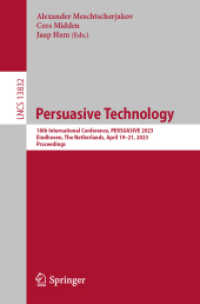- ホーム
- > 洋書
- > 英文書
- > Psychology
Contents
Introduction to the 3rd Edition
Preface to 2nd Edition
About the Companion Website
Chapters
1. Systems Orientation
a. Assumptions of a Family Systems Model
b. The Systems Orientation in Theory
c. The Systems Orientation in Practice
d. The Systems Orientation in Concepts
e. Levels of Systems Interventions
f. Cause and Effect in Systems
g. The Systems-Oriented Program Assessment
h. Working Alongside the Medical Model
i. Concluding Thoughts
2. Fundamentals of Family Work
a. Learning Family Counseling
b. Why Family Work
c. Rationales for This Approach
d. Uses of Family Counseling
e. Forms of Family Work
f. Bedrock Beliefs About Families
g. A Theory of Change
h. Children Raise Adults
i. Neglected Relationships in Family Counseling
j. Getting a Grip on the Obvious
k. Too Many Variables
l. Too-Brief Family Counseling
m. Traveling Pairs of Concepts
n. Questions and Answers
o. Concluding Thoughts
3. Structuring Family Sessions
a. Four Basic Tools for Family Counseling
b. General Guidelines
c. Session-by-Session Guidelines
d. Session Checklist for Family Counseling
e. Review Lists for Family Counselors
f. Family Work in Different Settings
g. Family Counseling Online
h. Concluding Thoughts
4. Engaging Families
a. Recruiting Families
b. Family Questions in Individual Counseling
c. Conducting the Initial Family Interview: The ReSPECT Sequence
d. Tips for the First Family Interview
e. Family Resistance
f. Difficult Parents
g. Child Diagnosis in Plain English
h. Concluding Thoughts
5. Case Conceptualization
a. Guiding Principles
b. Family Mapping
c. The MIGS Sheet
d. Therapeutic Themes By Family Type
e. Working with Adolescents and Children
f. Concluding Thoughts
6. Use of Self
a. Self Awareness
b. Fear of Family Work
c. Experience is Primary
d. Counselor Development as a Systems Practitioner
e. Clinical Self-Assessment
f. Induction/Countertransference
g. Conscious Use of Self
h. Colleague Consultation
i. Concluding Thoughts
7. Cultural Awareness in Family Work
a. Cultural Awareness
b. Dynamic Diversity
c. Special Populations
d. Concluding Thoughts
8. Systemic Techniques
a. Tools of the Trade
b. Alter Ego
c. Brief Network Intervention
d. Chair Work
e. Circular Questions
f. Colleague Teamwork
g. Drawings
h. Guardrail
i. New Talk
j. Paradox
k. Parent's Childhood
l. Reflecting Team
m. Reframing
n. Relabeling
o. Safe Rebellion
p. Sculpting and Movement
q. Sibling Talk
r. Strategic Child Assessment
s. Strategic Predictions
t. Toybox
u. Worried Child
v. Summary of Systemic Techniques
w. A Sequential Model of Family Therapy
x. Concluding Thoughts
9. Working with Couples
a. General Guidelines
b. Couples Counseling: Additional Tips
c. Couples Work for Substance Use Disorder
d. Couples Counseling Clinical Model of Practice
e. Concluding Thoughts
10. Working with Multiple Families
a. Multiple Family Group Counseling
b. Suggested Procedures for Multiple Family Groups
c. Family Recruitment for Multiple Family Groups
d. Clinical Tips
e. Therapeutic Activities
f. Who's Missing
g. Elemental Schema for Multiple-Family Group Therapy
h. Concluding Thoughts
11. Working with Addictions in Families
a. Defining Substance Use Disorder
b. Useful approaches to Problematic Substance Use
c. Common Patterns in Families with Substance Use Disorder
d. Adolescents with Problematic Substance Use
e. Codependency
f. Engaging Families with Substance Use Problems
g. Family Counseling for Substance Use Disorders
h. Concluding Thoughts
12. John T. Edwards Biography
13. Green Book
Index







